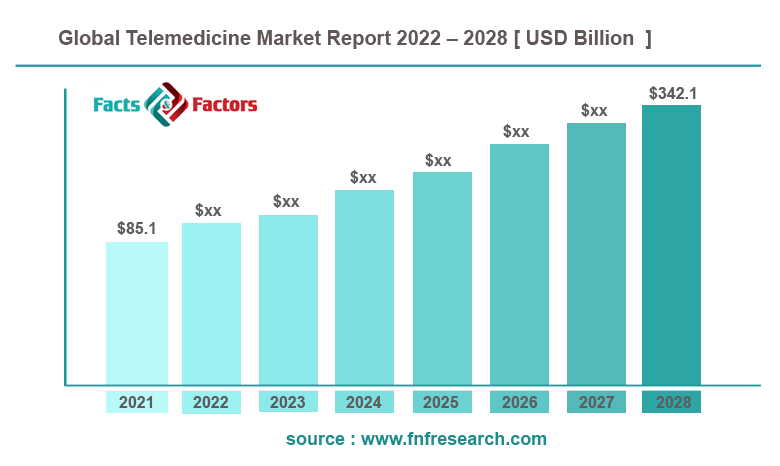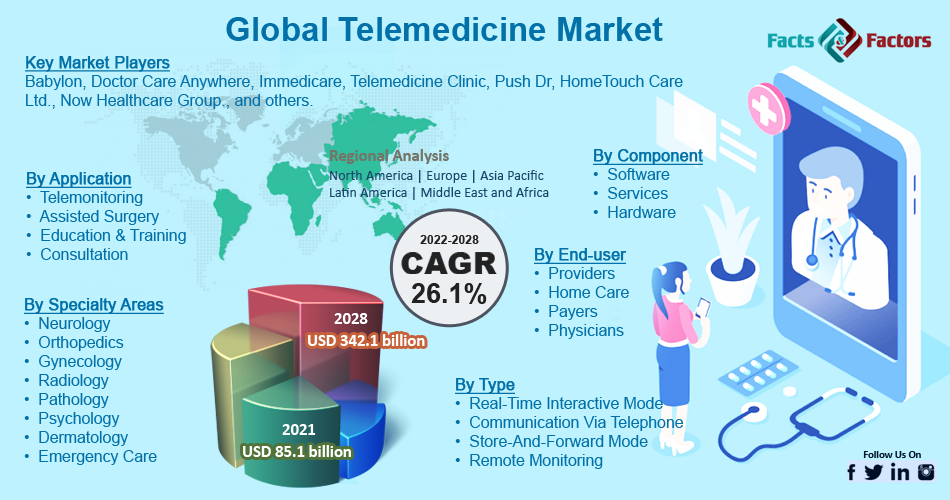Search Market Research Report
Telemedicine Market Size, Share Global Analysis Report, 2022 – 2028

Telemedicine Market Size, Share, Growth Analysis Report By Component (Software, Services, Hardware), By Type (Real-Time Interactive Mode, Communication Via Telephone, Store-And-Forward Mode, Remote Monitoring), By Application (Telemonitoring, Assisted Surgery, Education & Training, Consultation), By Specialty Areas (Neurology, Orthopedics, Gynecology, Radiology, Pathology, Psychology, Dermatology, Emergency Care), By End-User (Providers, Home Care, Payers, Physicians), and By Region - Global and Regional Industry Insights, Overview, Comprehensive Analysis, Trends, Statistical Research, Market Intelligence, Historical Data and Forecast 2022 – 2028
Industry Insights
[211+ Pages Report] According to the report published by Facts & Factors, the global telemedicine market size was worth around USD 85.1 billion in 2021 and is estimated to grow to about USD 342.1 billion by 2028, with a compound annual growth rate (CAGR) of approximately 26.1% over the forecast period. The report analyzes the telemedicine market's drivers, restraints/challenges, and the effect they have on the demands during the projection period. In addition, the report explores emerging opportunities in the telemedicine market.

 Market Overview
Market Overview
The remote delivery of healthcare services through the telecommunications infrastructure, such as tests and consultations, is known as telemedicine. It is sometimes known as telehealth or e-medicine. According to recent data, 90% of organizations have either begun or implemented telemedicine initiatives. Even more modest independent medical practices are beginning to use telemedicine to compete with neighborhood retail clinics and stem patient attrition. Telemedicine may enhance patient access to healthcare, lower medical expenses, and increase productivity & profitability. This will have a beneficial effect and fuel the expansion of the telemedicine industry. In the wake of the pandemic, demand for healthcare products and services rose to an all-time high. In addition, technology like telemedicine, chatbots, and others are being used to aid with information gathering, population reassurance, patient treatment, and diagnosis.
Additionally, several nations fund cutting-edge technology and telecommunications to link doctors remotely. As a result, it is anticipated to have a favorable effect during the forecast period. Telemedicine systems may also provide the patient with automatic instruction and direction through a series of questions and responses processed by the system's software algorithms.
 COVID-19 Impact:
COVID-19 Impact:
Telemedicine has become a crucial part of healthcare during the COVID-19 epidemic, and the populace has mostly embraced it. As a result, the market has experienced tremendous development and is expected to expand quickly over the upcoming years. On the other hand, the UK telemedicine market is expected to develop more quickly than average throughout the projection period due to factors including high literacy rates, an improving socioeconomic situation, an older population, and a sizable rise in patients with chronic illnesses.

 Key Insights:
Key Insights:
- As per the analysis shared by our research analyst, the global telemedicine market value is expected to grow at a CAGR of 26.1% over the forecast period.
- In terms of revenue, the global telemedicine market size was valued at around USD 85.1 billion in 2021 and is projected to reach USD 342.1 billion by 2028.
- The growing need to oversee patients and treat them for ongoing illnesses and mental health concerns using telemedicine techniques like telepsychiatry from remote places is fueling the rise of the telemedicine market.
- By component, the software category dominated the market in 2021.
- By application, the telemonitoring category dominated the market in 2021.
- North America dominated the global telemedicine market in 2021.
 Growth Drivers
Growth Drivers
- Increased development of telehealth systems drives the market growth
The global telemedicine market is expanding as a result of cutting-edge telehealth solutions. For example, a digital care assistant has been introduced by the "virtual doctor" startup Babylon Health to help individuals identify and treat ambiguous COVID-19 contaminations. The care assistant may be used at any time, according to the company, whose GP at smartphone app is being used in the National Health Service (NHS), to assess symptoms, document disease, combat self-isolation, and maintain a connection with medical personnel. Following each person's specific needs, Babylon claims that the revolutionary COVID-19 service delivers relevant information and treatment for each individual, devoting doctors' attention to the patients who need it most.
 Restraints
Restraints
- Medical fraud may hinder the market growth
Healthcare fraud is a critical element in telehealth and telemedicine operations. A patient or a doctor may become a victim in several ways, such as when institutional providers who are ineligible or not listed use incorrect coding and billing for false claims or when the doctor's name and accounts are used fraudulently to get money from the insurance carrier. Such fraudulent conduct may harm people's faith and confidence in telemedicine services. Victimized patients commonly vent their terrible experiences in the media, which has a debilitating effect on a large number of just enrolled participants and restricts market expansion.
 Opportunity
Opportunity
- Analytics and AI to present market growth opportunities
To allow risk prediction and management, big data analytics may analyze data gathered from telemedicine modalities, including objective (vital signs and ambient environment), subjective (symptoms and patient behaviors), and historical data. Additionally, during the epidemic, government organizations, major commercial insurers, and public payers have increased access to telemedicine. Most of them are working hard to ensure that telemedicine is used on the appropriate patients with the proper healthcare requirements, boosting effectiveness and efficiency in healthcare delivery. As medical delivery adjusts to the widespread use of telemedicine, there seems to be considerable promise in analytics, AI, and machine learning. Data-driven analytics is thus a crucial component in guaranteeing the efficacy and efficiency of telemedicine.
 Challenges
Challenges
- The lack of understanding, behavioral impediments, and the cost of healthcare are the major challenges for the market
Although they may not be the most evident barrier, behavioral barriers nonetheless provide a major obstacle to the adoption of telemedicine. Patients and doctors frequently lack knowledge of new techniques and are reluctant to abandon their traditional methods. Due to a lack of familiarity with the technology, older adults may also choose not to use telemedicine services. Only a small portion of the population in underdeveloped nations now relies on telemedicine services to meet their medical needs. This highlights the urgent need for ongoing patient education to raise public knowledge of telemedicine practices. The significance and necessity of telemedicine may be communicated through telecare (more precisely, patient education through television and radio), which is implemented with different government policies.
 Segmentation Analysis
Segmentation Analysis
The global telemedicine market is segregated based on component, type, application, specialty areas, end users, and region.
The market is divided into hardware, software, and services based on components. Among these, the software component proved one of the most lucrative segments in 2021. The service platform can be further bifurcated into tele-home & mHealth, and the hospital. The tele-home & mHealth segment accounted for the greatest market share. This rise is attributable to an aging population increasingly choosing tele-home options such as personal emergency response service (PERS) gadgets for remote consulting services. A personal emergency response system might give one peace of mind knowing that help is only a button push away. It can be the greatest medical alert system for a senior family member.
The market is classified into real-time interactive mode, communication via telephone, store-and-forward mode, and remote monitoring. The real-time interactive way led the market in 2021 and is expected to maintain its dominance during the forecast period. This results in more people using on-demand medical consultations, mHealth & virtual video visits, and more major market participants providing services.
Based on application, the market is segmented into telemonitoring, assisted surgery, education & training, and consultation. In 2021, telemonitoring dominated the market.
Based on a specialty area, the market is classified into neurology, orthopedics, gynecology, radiology, pathology, psychology, dermatology, and emergency care. The radiology segment dominated the market in 2021. This is a result of several factors, including, among others, an increase in imaging practices, healthcare providers' acceptance of teleradiology workflow, the expansion of service offerings within radiology sub-segments, and the streamlining & regulation of teleradiology operations. Major growth drivers during the anticipated period will include the adoption of the Picture Archiving and Communication System (PACS), integrating Artificial Intelligence (AI) into teleradiology, and expanding eHealth-related research and development activities.
The market is classified into providers, home care, payers, and physicians based on end-users. Providers held significant growth in 2021.
 Recent Developments
Recent Developments
- July 2021: Doro Care UK said the COVID-19 discharge service would begin working alongside NHS Cheshire CCG. The program supports quick hospital discharges throughout Cheshire.
 Report Scope
Report Scope
Report Attribute |
Details |
Market Size in 2021 |
USD 85.1 Billion |
Projected Market Size in 2028 |
USD 342.1 Billion |
CAGR Growth Rate |
26.1% CAGR |
Base Year |
2021 |
Forecast Years |
2022-2028 |
Key Market Players |
Babylon, Doctor Care Anywhere, Immedicare, Telemedicine Clinic, Push Dr, HomeTouch Care Ltd., Now Healthcare Group., and others. |
Key Segment |
By Component, Type, Application, Specialty Areas, End User, and Region |
Major Regions Covered |
North America, Europe, Asia Pacific, Latin America, and the Middle East &, Africa |
Purchase Options |
Request customized purchase options to meet your research needs. Explore purchase options |
 Telemedicine Market: Regional Landscape
Telemedicine Market: Regional Landscape
- North America dominated the telemedicine market in 2021
North America had the largest global telemedicine market share in 2021. The increasing digitization of healthcare, the development of state-of-the-art healthcare facilities, and the widespread use of telemedicine technology are a few factors that contribute to this region's growth. The presence of large corporations has a greater impact on the region's considerable market share. This rapid expansion results from several factors, including the availability of a huge patient population pool, an increase in internet access, and a rise in demand for healthcare support, particularly in rural regions.
 Telemedicine Market: Competitive Landscape
Telemedicine Market: Competitive Landscape
- Babylon
- Doctor Care Anywhere
- Immedicare
- Telemedicine Clinic
- Push Dr
- HomeTouch Care Ltd.
- Now Healthcare Group.
Global Telemedicine market is segmented as follows:
 By Component
By Component
- Software
- Services
- Hardware
 By Type
By Type
- Real-Time Interactive Mode
- Communication Via Telephone
- Store-And-Forward Mode
- Remote Monitoring
 By Application
By Application
- Telemonitoring
- Assisted Surgery
- Education & Training
- Consultation
 By Specialty Areas
By Specialty Areas
- Neurology
- Orthopedics
- Gynecology
- Radiology
- Pathology
- Psychology
- Dermatology
- Emergency Care
 By End-user
By End-user
- Providers
- Home Care
- Payers
- Physicians
 By Regional Segment Analysis
By Regional Segment Analysis
- North America
- The U.S.
- Canada
- Mexico
- Europe
- France
- The UK
- Spain
- Germany
- Italy
- Nordic Countries
- Denmark
- Sweden
- Norway
- Benelux Union
- Belgium
- The Netherlands
- Luxembourg
- Rest of Europe
- Asia Pacific
- China
- Japan
- India
- Australia
- South Korea
- Southeast Asia
- Indonesia
- Thailand
- Malaysia
- Singapore
- Rest of Southeast Asia
- Rest of Asia Pacific
- The Middle East & Africa
- Saudi Arabia
- UAE
- Egypt
- South Africa
- Rest of the Middle East & Africa
- Latin America
- Brazil
- Argentina
- Rest of Latin America
Industry Major Market Players
- Babylon
- Doctor Care Anywhere
- Immedicare
- Telemedicine Clinic
- Push Dr
- HomeTouch Care Ltd.
- Now Healthcare Group.

Copyright © 2024 - 2025, All Rights Reserved, Facts and Factors


